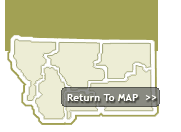

| Home | Communities | Accommodations | Places To Go | Things To Do | Site Map |
|
Glacier Country
Central Montana
Missouri River Country
Southwest Montana
Yellowstone Country
Southeast Montana
|

| ||||
 Shelby was named after Peter P. Shelby, general manager of the Montana-Central Railroad. In 1891 the Great Northern was making its way to Marias Pass; the builders threw a box car from the train and called it a station. Shelby himself is believed to have said that Shelby wouldn't amount to much. He was wrong; Shelby grew into a distribution for a trade center for 50 miles in every direction.
Shelby was named after Peter P. Shelby, general manager of the Montana-Central Railroad. In 1891 the Great Northern was making its way to Marias Pass; the builders threw a box car from the train and called it a station. Shelby himself is believed to have said that Shelby wouldn't amount to much. He was wrong; Shelby grew into a distribution for a trade center for 50 miles in every direction. In the late 1890s the town was a cowboy town with hardly any fences or homesteaders. By 1913 there were 5,000 entries for land in just one office. Homesteaders flooded into the area. The homesteaders suffered droughts and became very desperate. By the 1920s there was an exodus of homesteaders. In 1921 Gordon Campbell, a geologist, found oil that stretched all the way to the Canadian border. New life came to Shelby. Shelby is historically significant for the Dempsey-Gibbons World Heavyweight Championship prizefight held there on July 4, 1923. An excellent Indian artifact collection is on display at the Toole County Library.
The Marias River, named after Meriwether Lewis' cousin, winds its way through town, past the Marias Valley Golf Course and Country Club as well as Williamson Park, where camping and outdoor recreation can be found. While in town, visit the Marias Museum of History and Art for a look at area history, homesteading, a dinosaur collection and more. Nearby, the Sweet Grass Hills offer hiking and wildlife viewing, although they are almost exclusively on private property (434-7184). Deer, antelope, elk, foxes, golden eagles, grouse and the unique “sweet grass” can be seen in these hills. North of town, Lake Shel-oole offers camping and outdoor recreation (434-7184).
Elevation: 3,086 feet
Shelby is located in northcentral Montana, 36 miles from the Canadian border.
Shelby AccommodationsHotel/Motel (8)Private Campground (2) Shelby RestaurantsFamily Restaurant (3)Steak House (1) | All Shelby BusinessesAutomobile Service (2)Banking Service (3) Church (4) Florist (1) Gift Shop (2) Hardware Store (1) Jewelry Store (1) Library (1) Museum (1) Public Golf Course (1) Rail Service (1) Recreation Area Campground (2) River (1) Scenic Highway (1) Service Station (3) Specialty Store (2) Styling Salon (2) Visitor Information Center (1) |
Cities near Shelby Montana
| Brady Bynum Carter Chester | Choteau Conrad Cut Bank Dutton | Ethridge Galata Kevin Ledger | Lothair Oilmont Pendroy Santa Rita | Shelby Sunburst Sweetgrass. Valier |
A source for Montana Travel & Tourism Information
![]()